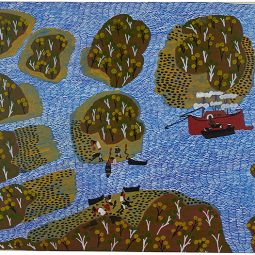In the 1940s, primarily in New York, Robert Motherwell (1915-1991) was at the epicentre of a new vanguard art movement – Abstract Expressionism. During a career that spanned half a century, he created an extensive body of work and was often credited as ‘reinventing’ and ‘refining’ signature themes and concepts, especially in collage.
Motherwell was considered one of the leading exponents of the movement and a pre-eminent figure in that generation of cutting-edge artists, branding the art movement in America by narrowing it to a specific kind of art that purportedly channelled emotion through gesture. An exhibition of his works at Annandale Galleries, Sydney this September will further define Motherwell’s role as a charter member of Abstract Expressionism by showcasing a selection of his collages, drawings and original lithographs and etchings.
He produced some of the most innovative and profound imagery of the 20th century, such as the Elegy to the Spanish Republic, Iberia, Open, and Summertime in Italy series, as well as an avant-garde oeuvre in collage. He would incorporate random detritus from his life in and out of the studio. In addition to sheet music and cigarette papers, the collages include paper bags, mailing wrappers, newsprint, postage stamps and handwritten notes – supporting his early belief that collage might serve as a kind of still life for abstraction, incorporating autobiographical elements.
During the course of his career, Motherwell made almost 900 collages, but his major innovation with collage is the torn paper edge – a technique that reflected his love of working with paper as much as his commitment to automatism and tapping into the unconscious. His enthusiasm for and dedication to the collage medium sets him apart from other artists of his generation and extended beyond the mere physical presence of pasted cut-and-torn papers. They contributed to another layer to the emotional density he searched for in his works. Motherwell believed collage to be “the 20th century’s greatest innovation” in which “one has the whole world and human history as subject matter, juxtaposition inconceivable before modern times.”

In the 1970s and 80s, Motherwell developed entire series of collages. The collage elements in these later works were often cut and torn fragments of proofs of his own prints that he embellished with gestural brushstrokes and painted compositions, and are demonstrative of his work with the torn edge.
Motherwell had also made colour a central element in his collage work, using it with an experimental boldness. A fervent admirer of Matisse throughout his life, and like Matisse, Motherwell himself became a phenomenal colourist who sought out earthy ochres, brilliant yellows and oranges, startling reds and sky lit blues and violets – bringing his work to life and creating an emotion.
However, Motherwell also found a reservoir of expressive possibilities in the stark polarity of black against white. Indeed, exploitation of the expressive possibilities of black and white – mainly in his Elegies – has been one of Motherwell’s central artistic concerns. These bold, strong abstract forms suggesting deep, open-ended meanings create a pathos and inimitable power that appeals to the viewer’s emotions.

Abstract Expressionism sought to recover the lost or hidden meaning of reality through a deliberate exploitation of spontaneity and feeling, and this is precisely what Motherwell accomplished. This exhibition is an invitation to witness and reflect on Motherwell’s long and distinguished career, his reinvigorating and refining of the collage art form.
Annandale Galleries
3 September to 4 October, 2014
Sydney
Study in Watercolour No. 6, 1968, watercolour on paper, 77.5 x 55.9cm
Untitled, 1973, acrylic on paper, 79.1 x 106.6cm
Courtesy Annandale Galleries, Sydney


